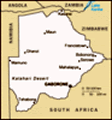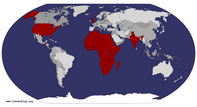Advertisement
Published: January 7th 2008
BOTSWANA
PART II
ON ALL FOURS
The first person to eat an oyster must have been at least as courageous as the first person to eat a mopane worm, or at least as hungry. That thought crossed my mind when we were with Paul, one of the rangers at Mashatu Game Reserve.
We were out talking a walk, no big deal.
On second thought… BIG DEAL.
Up until this point our eyes here searched the distance. We scanned the crests of far off hills, squinted into distant thickets of mopane trees and tall grasses, glassed down the eroded canyons of watercourses. We looked for creatures that could be measured in tons. Today, we followed Paul on foot and within ten minutes we were down on our hands and knees inspecting little rocks, focusing on species that weighed fractions of a gram.
He was so comfortable, knowledgeable, and in love with the minutia of this otherwise grandiose place that I forgot to worry about things like elephants, leopards and lions. Of course Paul had a lovely thirty-pound rifle slung over his shoulder. That may have had something to do with my comfort level.
His was a born teacher, using delicious melting, nut filled chocolate metaphors to explain the erosion and geology of the place. Along with his rifle he also carried a bird book to show us the different species we’d seen or heard. After his little lessons about quick cooling or slow cooling rock, or the manner in which different animals lay down their tracks, he quizzed us, his eyes twinkling while he waited for the answer.
“See these tracks? Why do you think the front feet are larger than the back feet? Why is the inside of this rock crystallized? Why do we find these leopard tracks in the gravel of a riverbed? How do you think these water holes were formed?”
Paul’s camera had a macro ability that allowed him to slide his lens right into the mug of a butterfly or a spider. He approached the insects like a Zen master, slowly, breathlessly, and then captured them. He had one incredible shot in his camera of a colorful butterfly perched on a green leaf drinking from a glistening dewdrop.
We walked quietly among the thousands of stunted trees that elephants munch on. Occasionally there was
a tall tree that had somehow managed to mature. The rest of them were alive, green, healthy, but pruned back like so many bonsais. If there were no elephants in Mashatu we would be walking in the dappled light of a dense forest.
Paul stopped suddenly and held up his right hand as if he had spotted a crouching leopard up ahead. But no, it was the huge web of a pair of spiders, male and female, who were suspended, motionless, in the gap between these low trees. The web had one very white zigzag stitch that ran through it as if some itinerant seamstress had stopped by to fix a tear in their fabric. A “stabilizing stitch” Paul called it. The male was small and monochrome brown. The female was huge, yellow and black, and her body looked as if an artist with affiliations to X-Man comics had sculpted it out of wax.
“It’s the opposite with birds isn’t it?” Paul said, another quiz forming in his mind. “The female is the one who is adorned, the male is the plain one. She wraps her prey in a cocoon of silk then injects it with some digestive
enzymes. Later she returns to drink what’s left in the cocoon.”
Delicious.
Soon after we came across another web, but this one had no discernible “spider” pattern. It looked as if a rebellious arachnid from the cubist school had made it. It turns out that a whole commune of cubists spun this one. Paul tells us this web belongs to a group of “community spiders” all living in an “apartment building” in the tree next door. And there we see it, a nest of sorts, where apparently thirty or so spiders live happily (I assume) in rent-controlled contentment.
Then came the incredible sight of a tree covered with fat mopane worms (technically they are the larvae of the emperor moth). Apparently these are delicacies for the local folks in Botswana. These worms were slowly deforesting the tree before they moved on to the next, and the next - or before they were plucked off, gutted, boiled, then put into a nice mopane stew. While alive they looked as if they were wearing rugs woven by the Navajo. I can’t say what they look like in the stew, but if they were to retain their color in the
pot I’d say this would be the most remarkably colored stew one could feast his eyes on.
We moved on.
Paul bent to retrieve a branch that was scattered on the ground below an impressive tree. “Feel this,” he said, handing us the dark wood. The heft of this thing, about the size of a hammer handle, was almost shocking, more dense metal than wood.
Paul was smiling as we passed it back and forth, his eyes twinkling again with a childlike impatience to continue.
“Leadwood,” he said. And then there was this brief
duh, what else would they call it moment before he continued. “The Leadwood tree might be the oldest tree known to man. They carbon dated one recently and found it to be two thousand years old. By the diameter of this one I’d say it’s about fifteen to seventeen hundred years old. They make furniture from them now, but if you buy a piece you don’t want to have to move it too often.” It was a wild felling to stand in the shadow of such an elderly being.
If “Leadwood” was the perfect name for this tree, then “Elegant” was
the perfect name for the grasshopper. We saw him sitting among some tall grasses, moving slowly, stopping now and again to let us inspect him closely. And if binoculars are the perfect tool for spying big game, then reading glasses (or perhaps even a magnifying glass for those who are naturally gifted) are a must for these close encounters with little creatures. To miss a very close inspection of this remarkable “Elegant Grasshopper,” and simply glance at it from a distance, would be similar to reading the
Cliff’s Notes version of “War and Peace.”
Birds were in amazing abundance here. Their songs were ever-present, loud, and formed a thick background of sound. Nothing like I’d ever heard before. No sleeping past 5AM without earplugs in this place. And, again, the colors! Two - the Lilac Breasted Roller and the Carmine Bee-Eater - were flying works of impressionism. But they also reminded me to pay tribute to our own little summer Yellow Finches, our Cardinals, and even our Blue Jays.
And on we walked. Even dung heaps, or “impala middens,” were sources of knowledge as we discovered, part of an amazing ebb and flow of creation and destruction. Impalas
defecate in the same spot to mark their territory; their predators roll in the droppings to disguise their scent, thus making an indentation where water can collect. Animals come to drink there. Elephants roll in the water to cool themselves off, thus making it bigger and bigger. Soon they have created a shallow “pan,” one hundred meters in diameter. In the rainy season it holds the water and looks like a lovely little kettle pond. And here, when the baby impala comes to drink, the predator finds her.
We stopped to inspect the nest of the Brown Tree Frog. They produce white foam that solidifies into a soap-like block suspended from a branch above the water. Their little tadpoles safely develop in a type of amniotic fluid inside, until an enzyme is produced, dissolving the nest and dropping the tadpoles into the water below.
We saw a stunning little ruby red mite crawling through the deep impression of an elephant print. This somehow brought the micro and the macro together, or at least gave us another appreciation of those creatures that do not even make an easily discernible footprint.
And we walked.
After three hours we
were meandering along the pooled gravel bed of a watercourse, looking at leopard, kudu, and impala prints. I suddenly heard a low rumble in the distance and stopped. Paul and Kristen stopped too, listening.
“Elephant?” I asked.
Paul listened for a second, no more, then replied, his eyes laughing once again.
“Vehicle,” he said.
O.K., so I’ll keep my day job.
Mopane Worm Stew
Ingredients
1 cup of dried mopane worms, 1 onion, chopped, 2 green peppers, sliced, 6 tomatoes, diced, 1 tablespoon curry powder, litre water
Preparation
Wash the worms and boil them for 30 minutes. Drain, then add the rest of the ingredients and simmer for about an hour.
Notes
Although this dish is an excellent main course, it can be served with cornmeal porridge for a great breakfast.
Mopane worms, the caterpillars of the anomalous emperor moth Imbrasia belina, get their names from the mopane tree that they eat. They are eaten as an addition to the porridge diet of the Venda people of South Africa.
The guts are removed by squeezing, the worms are then boiled and left for a day to dry out in the sun. Once dried they can be used at any time for cooking. When cooked the worms are juicy and salty.
Warning ! All the recipes given here are based on traditional dishes eaten by people over many generations. There are small risks when eating insects, so it is recommended that:
Nobody with an allergy to shellfish, chocolate or dust should try these recipes.
All insects should be prepared exactly as described and thoroughly cooked before being eaten.
Although they look similar, you should never eat or even touch hairy caterpillars in Britain.
from liverpoolmusem.org
Advertisement
Tot: 0.148s; Tpl: 0.011s; cc: 12; qc: 61; dbt: 0.0605s; 1; m:domysql w:travelblog (10.17.0.13); sld: 1;
; mem: 1.2mb









